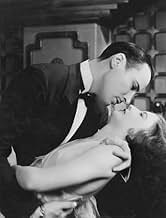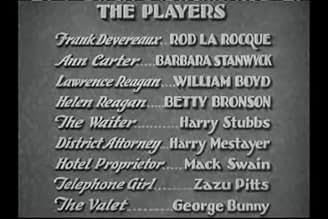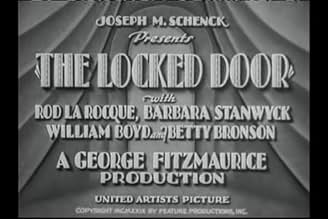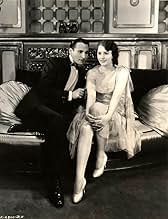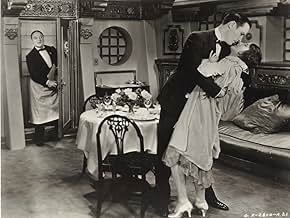IMDb RATING
6.0/10
625
YOUR RATING
On her first anniversary Ann Reagan finds that her sister-in-law is involved with a shady character from her own past, and determines to intervene.On her first anniversary Ann Reagan finds that her sister-in-law is involved with a shady character from her own past, and determines to intervene.On her first anniversary Ann Reagan finds that her sister-in-law is involved with a shady character from her own past, and determines to intervene.
Zasu Pitts
- Telephone Girl
- (as Zazu Pitts)
Mary Ashcraft
- Girl on Rum Boat
- (uncredited)
Violet Bird
- Girl on Rum Boat
- (uncredited)
Earle Browne
- Bit Part
- (uncredited)
Clarence Burton
- Police Officer
- (uncredited)
Lita Chevret
- Girl on Rum Boat
- (uncredited)
Gilbert Clayton
- Bit Part
- (uncredited)
Pauline Curley
- Bit Part
- (uncredited)
Edgar Dearing
- Cop
- (uncredited)
Edward Dillon
- Bit Part
- (uncredited)
Featured reviews
Barbara Stanwyck stars as Ann Carter, recently married to Lawrence Reagan (William Boyd). Their matrimonial bliss is disturbed by the appearance of Frank Devereaux (Rod La Rocque), a sleazy cad and serial womanizer who shared an embarrassing incident with Ann a year ago. When Ann learns that Devereaux has designs on Lawrence's young sister Helen (Betty Bronson), she decides to meet with Devereaux and try to keep him away from the young girl. This leads to scandal and tragedy.
Stanwyck was only 22 here, and this is her first starring role (she appeared as an uncredited showgirl in 1927's Broadway Nights). She's cute with dark hair and a baby face, and she's already exhibiting her star appeal. The Pre-Code story elements include traveling to an offshore "rum boat" (where a young Paulette Goddard is supposedly among the extras), implied forced sex, and Stanwyck spending a bit of screentime in a torn dress. La Rocque steals the film, though, as the dapper skirt-chaser who stays one step ahead of the cuckolded husbands left in his wake. He's detestable and funny at the same time.
This does show its early talkie roots though, with a dying scene that is so prolonged and talkie I'm surprised those surrounding the dying man don't start looking for a blunt instrument to end things. The overall effort is OK, but then again - Joe Schenck cut Buster Keaton loose to concentrate on films like this??? I guess you had to be there.
Stanwyck was only 22 here, and this is her first starring role (she appeared as an uncredited showgirl in 1927's Broadway Nights). She's cute with dark hair and a baby face, and she's already exhibiting her star appeal. The Pre-Code story elements include traveling to an offshore "rum boat" (where a young Paulette Goddard is supposedly among the extras), implied forced sex, and Stanwyck spending a bit of screentime in a torn dress. La Rocque steals the film, though, as the dapper skirt-chaser who stays one step ahead of the cuckolded husbands left in his wake. He's detestable and funny at the same time.
This does show its early talkie roots though, with a dying scene that is so prolonged and talkie I'm surprised those surrounding the dying man don't start looking for a blunt instrument to end things. The overall effort is OK, but then again - Joe Schenck cut Buster Keaton loose to concentrate on films like this??? I guess you had to be there.
BARBARA STANWYCK was never too fond of her first talkie and it's easy to see why. Filmed at a time when stage actors were just getting familiar with sound technique in films, it has a multitude of problems with regard to script, direction and performances.
ROD LaROCQUE is insufferably hammy as the bad guy who tries to seduce Stanwyck aboard an illegal rum boat and turns up some eighteen months later paying court to her sister (BETTY BRONSON). Stanwyck and hubby WILLIAM BOYD decide to stop LaRocque from carrying through with his plans to run off with Bronson and the plot thickens, going from one melodramatic mess to another before the story crawls to an end.
Best aspect of the film is the photography of Ray June, especially the overhead shots looking through the glass ceiling of a dance floor on the riverboat and the panning shot of bar customers ordering drinks.
Everyone sounds like they're reading their lines for a run through rehearsal, but Stanwyck at least shows emotion well in some good close-ups. Bronson and LaRocque are the worst with the new mikes.
ROD LaROCQUE is insufferably hammy as the bad guy who tries to seduce Stanwyck aboard an illegal rum boat and turns up some eighteen months later paying court to her sister (BETTY BRONSON). Stanwyck and hubby WILLIAM BOYD decide to stop LaRocque from carrying through with his plans to run off with Bronson and the plot thickens, going from one melodramatic mess to another before the story crawls to an end.
Best aspect of the film is the photography of Ray June, especially the overhead shots looking through the glass ceiling of a dance floor on the riverboat and the panning shot of bar customers ordering drinks.
Everyone sounds like they're reading their lines for a run through rehearsal, but Stanwyck at least shows emotion well in some good close-ups. Bronson and LaRocque are the worst with the new mikes.
Stagy but clever murder mystery with Barbara Stanwyck in her talkie debut and the center of attention.
The copy I have has a missing scene but this is still an effective if stagy and slightly hammy film.
Stanwyck is a secretary who goes to a boat party with the boss's son and maybe gets raped (that scene is missing) and raided by the police. She and the son skip bail and disappear. 18 months later we find Stanwyck happily married to a wealthy man (William Boyd) when his sister's new boy friend shows up. Yup it's the sleazy son (Rod LaRocque) with a new name. The sister (Betty Bronson) is gaga over him but Stanwyck is horrified.
Stanwyck overhears their plans to run off to Honolulu so she decides to pay LaRocque a visit. But unbeknown to her, her husband is also planning a visit because he has been warned about the boy friend.
Stanwyck arrives at LaRocque's apartment and starts a fight but is interrupted when the husband arrives. The guys scuffle and a gun goes off. Husband leaves and locks the door, trapping Stanwyck (hiding in a bedroom) in the apartment with the corpse. She thinks fast, rips her dress and calls the operator, pretending to fend off an attacker and firing the gun.
Both Stanwyck and Boyd eventually admit to the killing but then Bronson shows up.....
Supporting cast includes Zasu Pitts as the operator, Mack Swain as the manager, George Bunny as the valet, Purnell Pratt is a police man, and Harry Stubbs is the surprising waiter.
Neat little film apparently lost for decades.
The copy I have has a missing scene but this is still an effective if stagy and slightly hammy film.
Stanwyck is a secretary who goes to a boat party with the boss's son and maybe gets raped (that scene is missing) and raided by the police. She and the son skip bail and disappear. 18 months later we find Stanwyck happily married to a wealthy man (William Boyd) when his sister's new boy friend shows up. Yup it's the sleazy son (Rod LaRocque) with a new name. The sister (Betty Bronson) is gaga over him but Stanwyck is horrified.
Stanwyck overhears their plans to run off to Honolulu so she decides to pay LaRocque a visit. But unbeknown to her, her husband is also planning a visit because he has been warned about the boy friend.
Stanwyck arrives at LaRocque's apartment and starts a fight but is interrupted when the husband arrives. The guys scuffle and a gun goes off. Husband leaves and locks the door, trapping Stanwyck (hiding in a bedroom) in the apartment with the corpse. She thinks fast, rips her dress and calls the operator, pretending to fend off an attacker and firing the gun.
Both Stanwyck and Boyd eventually admit to the killing but then Bronson shows up.....
Supporting cast includes Zasu Pitts as the operator, Mack Swain as the manager, George Bunny as the valet, Purnell Pratt is a police man, and Harry Stubbs is the surprising waiter.
Neat little film apparently lost for decades.
George Fitzmaurice was one of the great commercial stylists among directors in the 1920s. He suffered an eclipse in the early talkie era but was fighting his way back into the majors when he died in 1940.
This means, of course, there are a lot of problems with this movie. The screen actors don't know how to do dialogue and most of the stage actors don't know how to turn down their performances for the intimacy of the movie camera. Barbara Stanwyck, looking very fresh-faced, is very loud in her line readings. She knows how to show her emotions beautifully already, though.
But producer Joe Schenck didn't spare any expense behind the camera, and it shows. Avant-garde cameraman Ray June handles the camera impeccably. While other directors were having their cameramen use cuts to change subjects, Fitzmaurice has June move the camera. Notice the long tracking shot at the bar in the opening sequence and the MOS shots used to fill out the sequence.
The camera-work is not fluid. It is, frankly, fairly clunky, but it is light years ahead of anyone else in the business in 1929, except possibly Mamoulian's APPLAUSE.
So while their are a lot of problems with this movie, the camera-work makes this one very superior for 1929 and Barbara Stanwyck makes it worth looking at.
This means, of course, there are a lot of problems with this movie. The screen actors don't know how to do dialogue and most of the stage actors don't know how to turn down their performances for the intimacy of the movie camera. Barbara Stanwyck, looking very fresh-faced, is very loud in her line readings. She knows how to show her emotions beautifully already, though.
But producer Joe Schenck didn't spare any expense behind the camera, and it shows. Avant-garde cameraman Ray June handles the camera impeccably. While other directors were having their cameramen use cuts to change subjects, Fitzmaurice has June move the camera. Notice the long tracking shot at the bar in the opening sequence and the MOS shots used to fill out the sequence.
The camera-work is not fluid. It is, frankly, fairly clunky, but it is light years ahead of anyone else in the business in 1929, except possibly Mamoulian's APPLAUSE.
So while their are a lot of problems with this movie, the camera-work makes this one very superior for 1929 and Barbara Stanwyck makes it worth looking at.
Other than the fact that this was Barbara Stanwyck's second film and talkie debut, believe me there isn't any other reason to remember The Locked Door. It's a rather turgid melodrama with some stock company heroes and villains. It might very well have been a play on the Cotton Blossom, but for its urban setting.
Barbara Stanwyck showed something in this film though, she wouldn't have had the career she had if she didn't. You can definitely spot the star quality with her.
The film is based on a Broadway play by Channing Pollock that ran 187 performances during the 1919-1920 season. The subject of Prohibition was new at that time, by 1929 it was old hat. In any event it's only part of the story.
Stanwyck and Snidely Whiplash villain Rod LaRocque are on a floating gambling and drinking boat when it's raided. They both jump bail and go their separate ways, Stanwyck thanking the Deity she had no further involvement with LaRocque.
But that's not what fate has in store for her. She marries William Boyd, a widower with daughter Betty Bronson. Guess who Bronson tells dear old Dad and step mom who she's involved with.
When both Stanwyck and Boyd go to confront LaRocque, but separately, that's when the action really starts.
One thing I will say in favor of the film, the camera work reminded me a whole lot of Alfred Hitchcock's famous one set films, Rear Window and Rope, because the story takes place in the last half in LaRocque's apartment. But the hammy acting and melodramatic plot date this film terribly.
Still Barbara Stanwyck's personality certainly stands out.
Barbara Stanwyck showed something in this film though, she wouldn't have had the career she had if she didn't. You can definitely spot the star quality with her.
The film is based on a Broadway play by Channing Pollock that ran 187 performances during the 1919-1920 season. The subject of Prohibition was new at that time, by 1929 it was old hat. In any event it's only part of the story.
Stanwyck and Snidely Whiplash villain Rod LaRocque are on a floating gambling and drinking boat when it's raided. They both jump bail and go their separate ways, Stanwyck thanking the Deity she had no further involvement with LaRocque.
But that's not what fate has in store for her. She marries William Boyd, a widower with daughter Betty Bronson. Guess who Bronson tells dear old Dad and step mom who she's involved with.
When both Stanwyck and Boyd go to confront LaRocque, but separately, that's when the action really starts.
One thing I will say in favor of the film, the camera work reminded me a whole lot of Alfred Hitchcock's famous one set films, Rear Window and Rope, because the story takes place in the last half in LaRocque's apartment. But the hammy acting and melodramatic plot date this film terribly.
Still Barbara Stanwyck's personality certainly stands out.
Did you know
- TriviaOther than one bit part, this is Barbara Stanwyck's feature film debut.
- Quotes
Ann Carter: You won't gain anything by keeping me here!
Frank Devereaux: Oh, I like you in a temper. I want to hold you close, knowing you don't want to be held.
- ConnectionsFeatured in Visions of Light (1992)
- SoundtracksI've Got a Feeling I'm Falling
(uncredited)
Written by Fats Waller and Harry Link
First tune played on the boat
- How long is The Locked Door?Powered by Alexa
Details
- Release date
- Country of origin
- Language
- Also known as
- The Locked Door
- Production company
- See more company credits at IMDbPro
- Runtime1 hour 14 minutes
- Color
- Aspect ratio
- 1.20 : 1
Contribute to this page
Suggest an edit or add missing content

Top Gap
By what name was Le signe sur la porte (1929) officially released in Canada in English?
Answer


